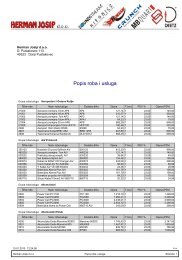and more often it is not possible to install radios ... - Herman Josip doo
and more often it is not possible to install radios ... - Herman Josip doo
and more often it is not possible to install radios ... - Herman Josip doo
Erfolgreiche ePaper selbst erstellen
Machen Sie aus Ihren PDF Publikationen ein blätterbares Flipbook mit unserer einzigartigen Google optimierten e-Paper Software.
Advice<br />
The right cable-qual<strong>it</strong>y<br />
a) The copper<br />
he sound qual<strong>it</strong>y of a system depends very much on the kind of<br />
Tcopper used for the wires. The cheap copper <strong>is</strong> available in many<br />
different qual<strong>it</strong>ies. It <strong>is</strong> called „pure“ copper if there are about 4500 copper<br />
crystals w<strong>it</strong>hin one meter of a copper conduc<strong>to</strong>r (OFC). The current has <strong>to</strong><br />
pass the edges of the crystals whereas d<strong>is</strong><strong>to</strong>rtions may ar<strong>is</strong>e. Although,<br />
oxygen-free copper still contains 235 parts of oxygen w<strong>it</strong>hin one meter.<br />
The first qual<strong>it</strong>y level <strong>is</strong> (OFHC) copper. The method of drawing th<strong>is</strong> wire<br />
reduces the number of oxygen parts down <strong>to</strong> about 40 oxygen-parts/m.<br />
The lower number of oxygen parts reduces the oxidation between the copper<br />
crystals. Further<strong>more</strong>, the material allows <strong>to</strong> quarter the number of<br />
copper parts which also reduces d<strong>is</strong><strong>to</strong>rtion <strong>and</strong> background no<strong>is</strong>es. The<br />
sound delivered by an OHC cable <strong>is</strong> softer, cleaner w<strong>it</strong>h <strong>more</strong> dynam<strong>is</strong>m<br />
<strong>and</strong> transparency.<br />
Further<strong>more</strong>, due <strong>to</strong> the silver-plated copper-wires the conductiv<strong>it</strong>y could<br />
be improved <strong>and</strong> the oxidation w<strong>it</strong>hin the conduc<strong>to</strong>r has been reduced. The<br />
sound character gains in freshness <strong>and</strong> a <strong>more</strong> genuine impulse transm<strong>is</strong>sion.<br />
Our loudspeaker-cables’ program also benef<strong>it</strong>s from th<strong>is</strong> resolute<br />
improvement the conduc<strong>to</strong>r has made:<br />
Loudspeaker-cable „Professional Line“ 4 sqmm<br />
b) The „skin-effect“<br />
he „skin-effect“ represents one of the greatest difficulties concerning<br />
Tcables. The exact meaning of th<strong>is</strong> term <strong>is</strong> <strong>often</strong> unknown. Most people<br />
think that „skin-effect“ means a loss in power <strong>and</strong> they can’t believe that<br />
<strong>it</strong> can take effect yet in the perceptible frequencies (20 – 20000 Hz)<br />
because of the fact that the 3-db-point (half-div<strong>is</strong>ion of power) of a cable<br />
normally ranges at about 50 kHz.<br />
In fact, the „skin-effect“ influences the values of res<strong>is</strong>tance <strong>and</strong> inductiv<strong>it</strong>y<br />
long before <strong>it</strong> causes a loss in power. As a consequence of these alterations<br />
some frequencies come upon res<strong>is</strong>tances whose sizes depend on<br />
the respective d<strong>is</strong>tance <strong>to</strong> the surface of the conduc<strong>to</strong>r.<br />
As a result of a <strong>to</strong>o large cross-section (<strong>more</strong> than 2,5 sqmm) especially<br />
the difficult high frequencies sound ind<strong>is</strong>tinctly. You can’t hear the details,<br />
the sound <strong>is</strong> dump <strong>and</strong> flat, as if there were no harmonic waves.<br />
Our LS-cable „PROFESSIONAL LINE 2,75 sqmm“ <strong>is</strong> equipped w<strong>it</strong>h<br />
cross-sections of the str<strong>and</strong>ed wires w<strong>it</strong>h different diameters.The largest<br />
diameter <strong>is</strong> placed in the centre of the cable. Low frequency signals are<br />
only transm<strong>it</strong>ted in the centre of the wire; for th<strong>is</strong> reason the method<br />
serves also as a sound tuning measure.<br />
Due <strong>to</strong> the specific arrangement of larger str<strong>and</strong>ed wire cross-sections<br />
which are intended <strong>to</strong> improve the damping fac<strong>to</strong>r of the output stage, a<br />
better impulse reproduction in the bass frequencies <strong>is</strong> achieved. The<br />
higher the frequency <strong>is</strong> the <strong>more</strong> the signals belonging <strong>to</strong> the middle/high<br />
frequency ranges are moving <strong>to</strong>wards the surface of a cable. In th<strong>is</strong> sec<strong>to</strong>r<br />
we used smaller cross-sections so that the „skin-effect“ can’t be <strong>not</strong>iced.<br />
194<br />
c) Capac<strong>it</strong>y <strong>and</strong> inductiv<strong>it</strong>y<br />
nlike the power cables the current flow in the RCA- <strong>and</strong> Speakercables<br />
U<strong>is</strong> alternating. The capac<strong>it</strong>y (like a capac<strong>it</strong>or) of a cable <strong>is</strong> determined<br />
by the d<strong>is</strong>tance between the wires (pos<strong>it</strong>ive or negative) as well as by the<br />
electric properties of the dielectric material (insulation material). The better<br />
the qual<strong>it</strong>y of the dielectric material <strong>is</strong> <strong>and</strong> the longer the d<strong>is</strong>tance between<br />
the conduc<strong>to</strong>rs <strong>is</strong>, the lower the capac<strong>it</strong>y <strong>is</strong> getting. As far as the inductiv<strong>it</strong>y<br />
(like a coil) <strong>is</strong> concerned <strong>it</strong>’s the other way round. The longer the<br />
d<strong>is</strong>tance between the conduc<strong>to</strong>rs <strong>is</strong>, the higher the inductiv<strong>it</strong>y <strong>is</strong> getting. In<br />
case of a <strong>to</strong>o high capac<strong>it</strong>y, high frequent signals are short-circu<strong>it</strong>ed. In<br />
case of a <strong>to</strong>o high inductiv<strong>it</strong>y, <strong>it</strong> opposes <strong>to</strong> the high frequent signals a high<br />
internal res<strong>is</strong>tance. Moreover, the length of a cable determines the values<br />
of inductiv<strong>it</strong>y <strong>and</strong> capac<strong>it</strong>y (the longer the higher). In our „SILVER LINE“<br />
cable the d<strong>is</strong>tance between the wires <strong>is</strong> larger <strong>to</strong> reduce the capac<strong>it</strong>y. In<br />
th<strong>is</strong> case the inductiv<strong>it</strong>y doesn’t influence the sound negatively.<br />
Our 4-channel symmetrical RCA-cable „MUNICH“ <strong>is</strong> equipped w<strong>it</strong>h 4 insulated<br />
cores whose special layout enabled us <strong>to</strong> reduce the inductiv<strong>it</strong>y<br />
dec<strong>is</strong>ively. The core layout can be parallel or tw<strong>is</strong>ted. Each variant has got<br />
<strong>it</strong>s own special advantages. It <strong>is</strong> true that capac<strong>it</strong>y <strong>and</strong> inductiv<strong>it</strong>y are slightly<br />
r<strong>is</strong>ing if the wire <strong>is</strong> tw<strong>is</strong>ted but their ratio <strong>is</strong> very advantageous. But the<br />
most important advantage <strong>is</strong> a better suppression of induced interferences<br />
mainly caused by the car electric system.<br />
Even though the values of inductiv<strong>it</strong>y <strong>and</strong> capac<strong>it</strong>y are <strong>not</strong> the most important<br />
character<strong>is</strong>tics of a cable they are aimed <strong>to</strong> be kept small during the<br />
development of a cable. Th<strong>is</strong> means practically that if the output impedance<br />
of a control un<strong>it</strong>’s preamplifier output <strong>is</strong> <strong>more</strong> than 500 Ohm <strong>and</strong> <strong>is</strong><br />
connected w<strong>it</strong>h the amplifier by means of a long high capac<strong>it</strong>y cable of<br />
<strong>more</strong> than 1000pF the res<strong>is</strong>tance in series <strong>and</strong> the parallel cable capac<strong>it</strong>y<br />
a kind of low bass. The result would be a lowering of the level in the<br />
high-frequency range.



